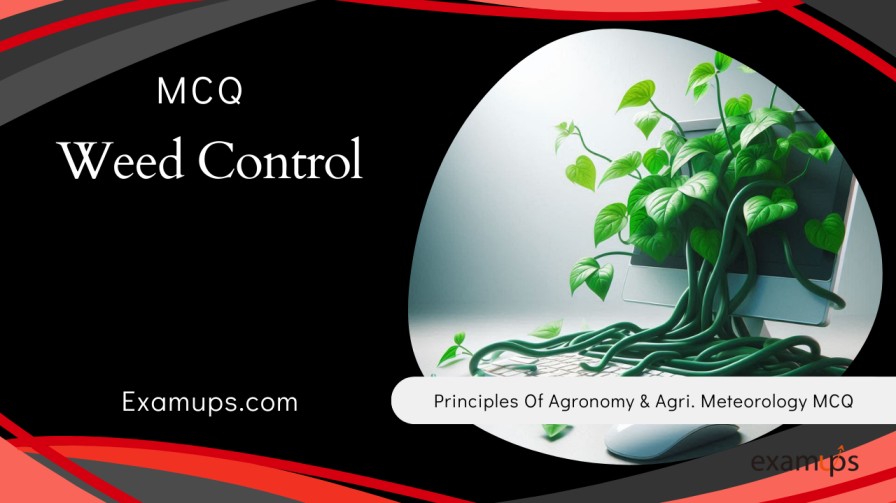MCQs on Weed Control like ICAR-JEF, ICAR-SRF, ICAR-NET, IBPS-AFO/SO, Pre-PG, BHU Pre-PG, IFFCO-AGT, CCI, FCI, B.sc, M.sc, etc.
MCQ on Weed Control
Question 1:
What is the general definition of a weed?
- A) A plant with positive value
- B) A plant growing where it is not wanted
- C) A plant growing in a controlled environment
- D) A plant used for medicinal purposes
Answer: B) A plant growing where it is not wanted
Explanation:
A weed is generally defined as a plant growing where it is not wanted. It can also interfere with intended land use and negatively impact crop production.
Question 2:
Which of the following is NOT a common loss due to weeds?
- A) Weeds reduce crop yields
- B) Weeds increase the quality of produce
- C) Weeds increase the cost of cultivation
- D) Weeds are alternate hosts for crop pests and diseases
Answer: B) Weeds increase the quality of produce
Explanation:
Weeds typically reduce the quality of produce by contaminating it. They are also known to increase cultivation costs, reduce yields, and act as alternate hosts for pests and diseases.
Question 3:
Which of the following is a common method to control weeds?
- A) Adding organic matter
- B) Applying herbicides
- C) Increasing soil compaction
- D) Adding more fertilizers
Answer: B) Applying herbicides
Explanation:
Herbicides are chemicals used to control weeds by targeting specific plant growth processes. They are one of the most common methods of weed control.
Question 4:
What is a potential health risk associated with weeds like Parthenium hysterophorus?
- A) Dermatitis
- B) Increased soil fertility
- C) Allergy
- D) Off-flavor in milk
Answer: C) Allergy
Explanation:
Parthenium hysterophorus can cause allergic reactions in humans, such as hay fever and respiratory issues like asthma.
Question 5:
Which of the following weeds can be an alternate host for the stem borer pest in rice crops?
- A) Cuscuta
- B) Echinochloa sp.
- C) Parthenium
- D) Wild onion
Answer: B) Echinochloa sp.
Explanation:
Echinochloa sp. serves as an alternate host for the stem borer pest in rice crops, contributing to the transmission and survival of pests.
Question 6:
What term describes the plant that interferes with the intended use of land?
- A) Crop
- B) Insect
- C) Weed
- D) Fungus
Answer: C) Weed
Explanation:
Weeds are plants that interfere with the intended use of land, competing with crops for resources and sometimes hosting pests and diseases.
Question 7:
What type of loss accounts for the highest percentage of agricultural losses in India due to weeds?
- A) Reduction in crop yields
- B) Increased cost of cultivation
- C) Reduction in produce quality
- D) Health problems in humans
Answer: A) Reduction in crop yields
Explanation:
Weeds compete with crop plants for resources like light, moisture, and nutrients, leading to a significant reduction in crop yields. In India, weeds account for 45% of the total agricultural loss.
Question 8:
Which of the following weeds is known to cause off-flavor in milk when found in fodder crops?
- A) Wild onion and wild garlic
- B) Xanthium
- C) Cuscuta
- D) Echinochloa sp.
Answer: A) Wild onion and wild garlic
Explanation:
Wild onion and wild garlic, when present in fodder crops, can impart an off-flavor to milk, affecting its quality.
Question 9:
Which of the following is an example of a weed control method that does NOT involve chemicals?
- A) Herbicides
- B) Manual weeding
- C) Insecticides
- D) Fungicides
Answer: B) Manual weeding
Explanation:
Manual weeding is a physical method of weed control that does not use chemicals. It involves manually removing weeds from fields or gardens.
Question 10:
Which of the following weeds can cause dermatitis upon contact with human skin?
- A) Helenium
- B) Parthenium
- C) Xanthium
- D) Franseria sp.
Answer: A) Helenium
Explanation:
Helenium is known to cause dermatitis upon contact with human skin, leading to irritation and other skin problems. Dermatitis can also be caused by Ambrosia and similar weeds.
More MCQs on Weeds
Question 11:
Which weed is known to cause itching and inflammation due to its hair-like structures?
- A) Urtica sp.
- B) Rhododendron sp.
- C) Lantana camara
- D) Sorghum halepense
Answer: A) Urtica sp.
Explanation:
Urtica sp., commonly known as nettles, can cause itching and inflammation due to its fine hair-like structures containing irritants.
Question 12:
Which weed is known to induce hypersensitivity to light in animals?
- A) Lantana camara
- B) Sorghum halepense
- C) Rhododendron sp.
- D) Eichhornia crassipes
Answer: A) Lantana camara
Explanation:
Lantana camara is a toxic weed known to induce hypersensitivity to light in animals, leading to severe skin issues.
Question 13:
What is the effect of Rhododendron sp. on animal health?
- A) Induces hypersensitivity to light
- B) Causes diarrhea and blood stains in milk
- C) Causes poisoning in cattle
- D) Causes skin irritations
Answer: B) Causes diarrhea and blood stains in milk
Explanation:
Rhododendron sp. can cause diarrhea and blood stains in milk when ingested by animals, indicating its harmful impact on animal health.
Question 14:
Which weed is poisonous to cattle and can lead to health problems if ingested?
- A) Urtica sp.
- B) Sorghum halepense
- C) Lantana camara
- D) Rhododendron sp.
Answer: B) Sorghum halepense
Explanation:
Sorghum halepense, also known as Johnsongrass, is poisonous to cattle and can cause serious health issues when consumed.
Question 15:
What is a potential problem caused by water contamination from weeds like Eichhornia and Typha?
- A) Reduced flow of water in irrigation channels
- B) Increased soil erosion
- C) Increased soil fertility
- D) Improved crop yields
Answer: A) Reduced flow of water in irrigation channels
Explanation:
Weeds like Eichhornia and Typha can block water flow in irrigation channels, reducing the efficiency of water distribution and potentially causing flooding or waterlogging.
Question 16:
Which of the following weeds is associated with reducing land value?
- A) Cyperus rotundus
- B) Amaranthus
- C) Lantana camara
- D) Imperata cylindrica
Answer: A) Cyperus rotundus
Explanation:
Cyperus rotundus (nutgrass) is a problematic weed that can be difficult to eradicate, reducing the value of land due to its persistent nature and impact on land use.
Question 17:
What does allelopathy refer to in the context of weeds?
- A) Harmful effects of plants due to the release of phytochemicals on other plants
- B) Beneficial effects of weeds on soil fertility
- C) Relationship between weeds and insects
- D) Effects of weeds on human health
Answer: A) Harmful effects of plants due to the release of phytochemicals on other plants
Explanation:
Allelopathy is the phenomenon where plants release phytochemicals that can negatively affect the growth and development of other plants.
Question 18:
Which weed is known for its potential medicinal value, particularly for treating snakebites?
- A) Leucas aspera
- B) Phyllanthus niruri
- C) Calotropis
- D) Argemone mexicana
Answer: A) Leucas aspera
Explanation:
Leucas aspera is used in traditional medicine to treat snakebites, among other medicinal uses, highlighting the potential benefits of some weeds.
Question 19:
Which weed has fodder value and can also be used for soil conservation?
- A) Cynodon dactylon
- B) Saccharum spontaneum
- C) Tephrosia
- D) Amaranthus
Answer: A) Cynodon dactylon
Explanation:
Cynodon dactylon, also known as Bermuda grass, has value as fodder and can be used for soil conservation due to its dense root system, which helps prevent soil erosion.
Question 20:
Which of the following weeds has potential for use in breeding due to its genetic diversity?
- A) Saccharum spontaneum
- B) Tephrosia
- C) Amaranthus
- D) Imperata cylindrica
Answer: A) Saccharum spontaneum
Explanation:
Saccharum spontaneum, a wild cane, is used in breeding programs due to its genetic diversity, providing new genes for crop improvement and other applications.










